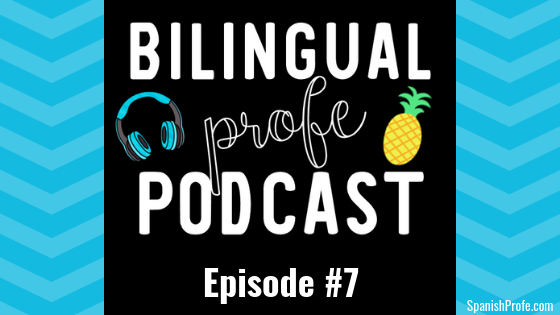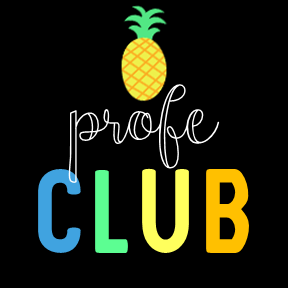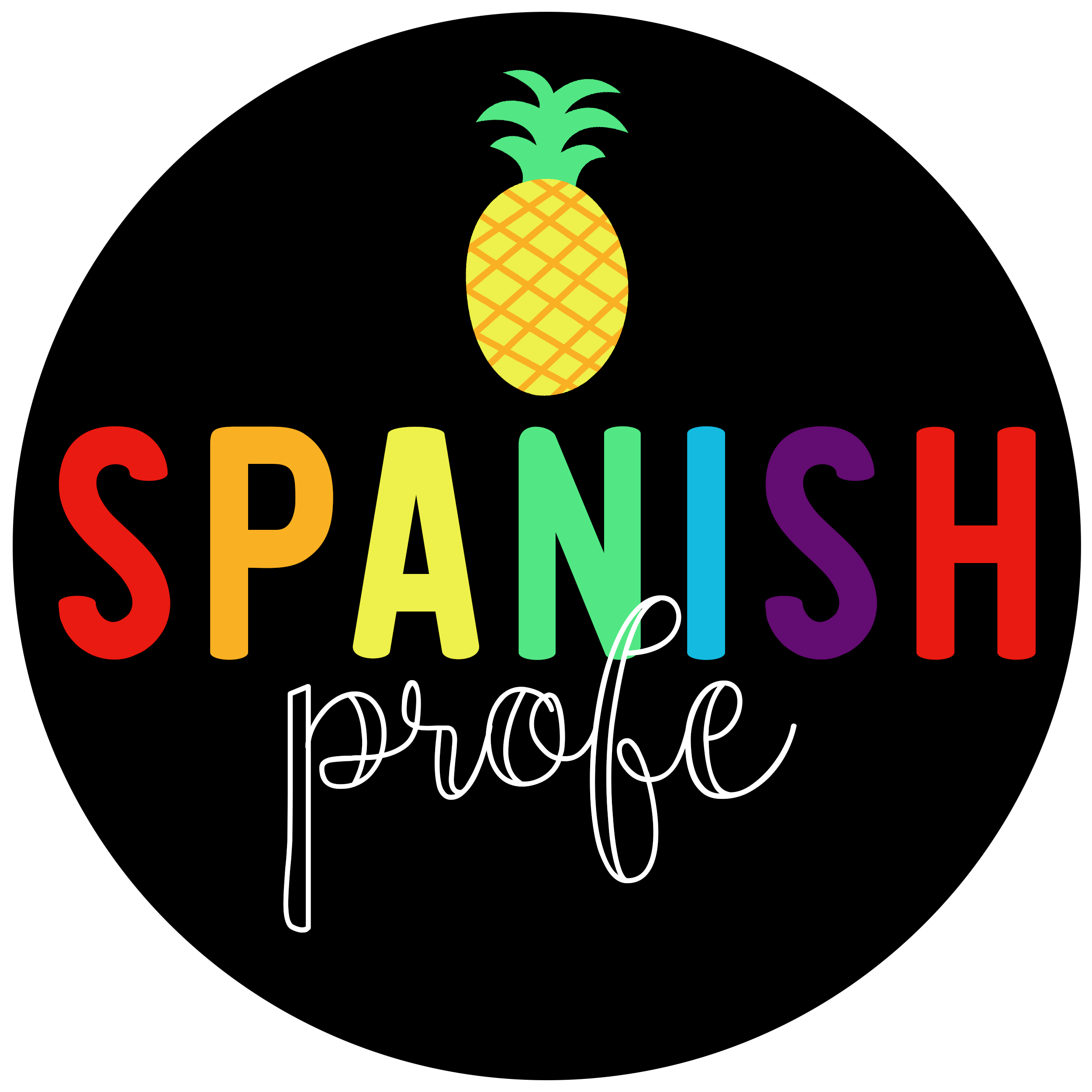
In episode 7, Janet talks about seven tips or ideas that you can use to get your students to speak more Spanish in the classroom.
Podcast: Download
FULL PODCAST TRANSCRIPT:
This is the Bilingual Profe Podcast. Today we talk ideas that you can use to get your students to speak more Spanish in the classroom. Stay tuned. The bilingual profe podcast is for busy bilingual teachers looking to improve their teaching practices in classroom. If you are a bilingual Spanish or dual language teacher than this is the podcast for you. We’ll talk tips, ideas, and best practices for your bilingual classroom.
Are you one of us? Come join the conversation at bilingualprofe.com.
Hey, hey–welcome back to the Bilingual Profe Podcast. I am Janet the host of this show. I hope you’re having a great week. Here it is cold and the snow just does not want to stop coming down. Thanks again for tuning in today. I will be talking about seven tips or ideas that you can use to get your students to speak more Spanish in the classroom.
Today’s episode is brought to you by Profe Club. Do you feel overwhelmed translating and creating resources in Spanish? Do you want to regain your prep time and weekends now? Join Profe club and get instant access to over 300 resources in Spanish for bilingual and Spanish immersion teachers that will help you regain your free time and feel more prepared for class. Go to profeclub.com to try it now for only $5.
So do you ever get frustrated because your students are always speaking in English in the classroom? Or they don’t seem to be putting much effort into speaking Spanish during class? When I taught first grade in a one way Spanish immersion program, I felt like I was always talking to myself. Or I felt like I was the only one in the classroom speaking Spanish. So I have come up with a few ideas that have worked over the years for me to get students to speak Spanish in your Spanish immersion or bilingual classroom? So tip number one, a gradual build up to 100% Spanish.
So basically when I worked in a one way immersion all of the students were English speakers. There weren’t any, there might have been one or two each year, but it was mostly native English speakers that were learning Spanish. So though I was speaking in Spanish the whole time, they amongst themselves often or almost always at the beginning were speaking only in English to each other. So at the beginning of the year we started working up throughout our schedule so we would do the morning meeting 100% in Spanish. Which meant that they had to respond and only speak in Spanish during that time. And then eventually we would add in language arts. All the students and obviously the teacher had to speak in Spanish the entire time and then eventually we would work up to winter break.
So the first let’s see four months of school, we would be working up to the entire day being in Spanish. And then right before the students went to winter break we would have a ceremony, a bridging ceremony and we would make a big deal and then invite the parents and families and basically the students signed certificate or contract with their teachers and the principal and well themselves and their families that after winter break they promise to only speak Spanish in the classroom. Now, so we made a big deal before winter break and then when they came back we would just remind them only Spanish now. And some teachers would decorate their door and just have celebrate that first day that oh now we’re 100% in Spanish. And then it really kind of helped the students know that we had built up to it and then now they could od it. The first couple days after winter break it was often quieter than it had been in the past. But they’d eventually were able to speak and use the language. And many were able to kind of step out of their comfort zone and use that language that they already knew in the back of their head but had been avoiding because they’re relying on speaking English.
So a gradual build up to 100% Spanish is a great idea. Tip number two, you could have table or group points or even classroom points. So if your goal is for your class to be speaking 100% Spanish during the day or at a certain time you could let them know I’m looking for tables or partners or whatever it is the entire class to be speaking in Spanish. If I see that you will get however many points, five points, two points, one point on the board and then you could have a class reward or a table reward that they could work up to. So it could be something like a movie in Spanish or extra recess or free time depending on what grade level you teach. So lots of students extrinsically motivated and they are motivated to speak in Spanish when they hear that they can get points and a possible reward or pajama days. We always have pajama days. Little kids love that.
So tip number two, that was table or group or class points. Tip number three, make sure that you give your students necessary words to ask for help or for clarification without going out of the language, their target language. So if you are expecting them to speak in Spanish, make sure that they know the words, the sentence stems to be able to do that. So do they know how to ask for help? Do they know how to say how do you say blank in Spanish? Or can you help me? Or what does blank mean in English? Do they know how to ask for clarification? It’s always though our expectation is that they speak 100% in Spanish. If we’re not giving them the resources they need to do that then it’ll be difficult for them. So make sure you are giving them those questions or sentence stems and encouraging them to use that in the target language to seek clarification if they need help with a word or something throughout the day.
Tip number four, now I’ve seen this in multiple different ways used. Basically it’s clothes pins. And I’ll explain because you’re not going to be pinching any students or anything. So I’ve seen it done two different ways. So basically the way I’ve done it is I’ve added three clothes pins to the caddy, the pencil caddy in the middle of the table. So at each table, so it was essentially a group thing. And then students were, this is once we’re already speaking in Spanish the whole day, and then if I heard English at a table, so not maybe just one word but conversations going on, I would first remind them that we’re speaking in Spanish only and then if they continued to speak in English I would take away one of the clips from their table.
Now, I did allow them to earn their clips back at the end of the day. So that was if they fixed it and they started speaking in Spanish and were doing a great job for the rest of the day then I would give them their third clip or both their clips back depending on how many they lost. Another version of this that some people do si that they give each student three clothes pins and they actually clip them on to their sleeve of their shirt and then if the teacher or the other students hear them speaking in English then they get to take one or their clips away. So again, you have to kind of gauge how your students would react to this. And what age group. I would never do this with kindergartners, or probably not even first graders. But maybe second or third graders would do well with this. Or even in a middle school Spanish language class you could try this. So any time you heard Spanish, or excuse me English, then you would take away a clip. So meaning that’s that visual reminder of oh no I’m down to one clip and I need to oops start speaking in Spanish again so I can earn my clips back.
Tip number five, encourage your students to ask a friend or classmate that knows. So often I think our students, especially the little ones see us as only expert in the room and they rely on the teacher or the teacher’s assistant as the only person that can help them, tell them how to say something or write a word or when they need help they just want to ask us. So you can always rely on that. Ask three before me. Especially in classrooms where you have populations of half of the class are native Spanish speakers and half of the class are native English speakers bilinguals. It’s very often that they need to be reminded that they can ask each other and they often can bounce ideas off of each other and figure out oh that’s how you say it without coming and interrupting you during your group time or guided reading time to get clarification on a word. So just remind students that hey like they’re experts around you in this classroom that speak Spanish. Ask them. Ask them how to say the word before you come and ask me.
And that also is great because it gives them the power of oh wow we’re in this together. We’re all learning languages. And they can learn to rely on each other and not just on the adult in the classroom.
Tip number six, have a lot of visuals in your classroom. So I kind of go a little bit overboard but I think that they really help language learners both your friends that are learning Spanish and then also those that are learning English. If there are pictures and visuals within the classroom just for centers, for signs to go to the bathroom, or get a drink, or things throughout the classroom are labeled with words, or there’s visual processes of when you are reading these are the three things you’re doing. Those really help our students know what to do. And even those non-readers so students in kindergarten can refer to posters like that with visuals and say oh number one, I’m supposed to get my book bin. Number two, read. Number three, pencil and paper. Oh I must be supposed to write about the story or draw a picture. So if you have those visuals available, student are often able to follow those processes without asking questions. So it’s really important to keep pictures and visuals up next to the words, especially in those lower grades so that they can become self-sufficient in the classroom.
And then tip number seven, it’s always really important to provide sentence stems in the classroom, not just during let’s see like writing time, but you can use sentence stems at any point in the classroom when you’re teaching academic, new academic lessons like science or reading or writing, anything new you can just write out a common sentence stem or something you would like to hear the students saying or writing and then that gives them an idea of what they should be the language they should be producing.
One way I use sentence stems in my classroom is during morning meetings I do a whip share which basically means that we go around the circle and we all start a sentence the same exact way. So for example on Fridays we might say “Yo voy a” and then they have to say somewhere where they’re going to go over the weekend. They could also say things like “Yo fui a” or “Yo comi” something they ate. Just any common sentence is a great repetition and then even if they don’t totally get what it means, by the time that it’s gone around the circle and however many kids, 20 kids have said that same sentence they kind of get a better meaning of what’s happening.
Also, morning meeting questions like do you like broccoli, yes or no kind of things where they have to respond yes I like broccoli or no I don’t. Having those repetitive sentence stems helps language learners a lot. Another way to get practice with sentence stems is by having simple games that expand vocabulary. So you’re probably thinking when would I do this. I often have just little simple games for example when we’re lining up or transitioning from one place to another is we have an extra minute or two. For example, if we’re getting in live, I’ll say raise your hand and tell me a word that starts with the letter M. And then we’ll go through half the class and if I see that oh well we actually need to go now. I can’t get through everyone. I’ll just say okay I’ll count to five and everyone whisper their answer to me. So it’s kind of giving them opportunities to think of things that they probably wouldn’t if we had just got in line and didn’t do anything they wouldn’t be practicing any sort of speaking and they’d just be waiting for each other.
Another we do okay who can tell us animals with four legs. So to get in line and often even if you have a line order there are some kids that want to get to their spot first. Also games that practice asking questions. 20 questions is a great one. Lots of our kids struggle with being able to ask questions. So I like to ask 20 questions of having a secret fruit to animal or whatever in your head and then they have to practice asking questions. That’s a great one. And I also do that to get mine at the end of the day or to go get your backpack. Just those times throughout the day where you need a buffer activity that takes two to five minutes. That’s a great thing.
So those are my seven tips for you to get your students to speak more Spanish in the classroom. If you have more ideas, hop on over to our website and leave us a comment with your ideas. Thanks again for listening to this episode of the podcast.
Thanks for tuning in. If you are a busy bilingual profe, I’d love to hear from you. Head over to bilingualprofe.com to connect with other bilingual educators just like you. See you next time. Bye.
Enjoy the podcast! We hope it gives you some ideas for your Bilingual, Dual Language or Spanish Immersion classroom.
Feeling overwhelmed? Get instant access NOW to over 350 resources in Spanish for Pre-K through 2nd grade bilingual and Spanish immersion teachers for less than $1/day? Try Profe Club for only $5 and start feeling more prepared TODAY!










